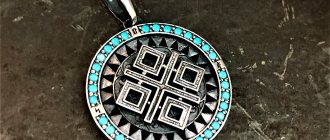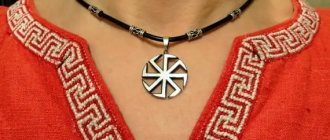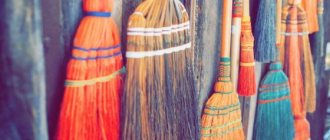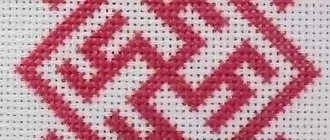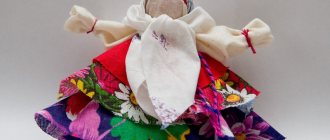Slavic women of the pre-Christian era had a strong patroness - Mokosha. She is also known under other names. Makosh, Mokusha, Mokosh - this was the name of the Slavic goddess depending on the region where she was mentioned. A traditional home amulet, embroidery with the image of Makosh, today decorates many homes, giving prosperity to the home, protecting the mistress and family.
Slavic goddess Makosh
Initially, there was a ban on images of the goddess’s face. She was presented as a woman with elongated arms, doing housework. Makosh is the oldest deity in the Slavic pantheon. She was considered the daughter of the Family itself, who gave life to all living things on earth. Her special status is evidenced by the fact that she turned out to be the only female idol of the pagan temple erected by Prince Vladimir. Later, Christian beliefs could not completely erase it from human memory. Makosh was reborn as the Orthodox Great Martyr Paraskeva Pyatnitsa, the patroness of the family hearth.
Goddess Makosh is the patroness of women, children and the hearth.
The very name of the goddess speaks about the worldview of the Slavs. “Kosht” means fate, predestination, “ma” means mother.
Together with his younger sisters Dolya and Nedolya, Makosh weaves a tapestry of fate, changing or interrupting human lives. Our ancestors believed that Mother, in the form of a bare-haired woman, appears among people. She gives her help and protection to those who endure life’s adversities with steadfastness. Those who complain about fate in despondency will face its disfavor.
Makosh was revered as the goddess of harvest and fertility, the patroness of housework, weaving and handicrafts. They asked her for help before important matters:
- sowing work;
- harvesting;
- cooking food;
- needlework;
- during childbirth.
People often brought yarn, pieces of home-woven flax, vegetables and fruits as gifts to Mother.
Makosh was glorified as a life-giving deity, therefore he was depicted accompanied by two elk mothers - goddesses in labor. In addition, the goddess had power over water and wells, which in ancient beliefs were considered the gateway to the world of Rule.
Patron of needlewomen
Most researchers agree that the name of the deity comes from the word “get wet,” and it’s not for nothing that Mokosha is the goddess of rain and rivers. An alternative version of the origin of the name is a connection with spinning, “mokos”: Makosh was also considered the patroness of spinners and weavers.
The ancient Slavs, apparently, were confused themselves - it was customary to sacrifice yarn to the goddess by throwing it into a well.
In mythology, her image bears a close resemblance to the Greek Moira sisters - Clotho, Lachesis and Atropos, three goddesses who spun, measured and cut the threads of human destinies. The similarity is emphasized by the fact that the pagans attributed assistants to the Spinner - Share with Nedolya.
Friday was dedicated to the goddess. Women revered this day as deeply as Sunday now. Any traditionally female crafts were strictly prohibited on Fridays. The offender risked exposing the entire family to God's wrath.
Symbolism and origin of the amulet
The Slavs revered their goddess, but did not fear her. Her images were used as amulets and amulets, applied to clothing, body jewelry, and household items. The Slavic amulet Makosh was performed in several versions:
- A full-length image was more often used in embroidery.
- The head image was 4 small rhombuses combined into one large one.
Makosh symbol.
This symbolism personified the unity and harmony of the four elements: fire, water, earth and air. And also connected the material and spiritual in a person. The first option was used for large undertakings related to economic activities. Moreover, the position of the goddess’s hands mattered. Mother was embroidered with her hands raised up in anticipation of the arrival of spring, in anticipation of a fertile year. Embroidery with hands down - harvest time, a symbol of the coming autumn.
The rhombic version was used as an individual amulet. It was applied to personal belongings, or in a modern version - to the skin. Traditionally, a symbol made with one’s own hands and worn constantly has greater power.
Protective embroidery Makosh on a pillow.
Charms Makosh
The goddess Makosh became a symbol and amulet. Makosh amulets are most often worn by women. This symbolism attracts wealth and prosperity, it helps strengthen family relationships, and helps in the search for true love. Since Makosh is the goddess of fertility, her amulets contribute to the continuation of the human race, and maintain a strong connection between an already born child and his mother.
In the 21st century, the easiest way is to make yourself a talisman or even embroidery with the silhouette of this deity, who will take care of a person and protect him.
Meaning for women and men
As a talisman, the symbol of the goddess is more suitable for a woman - the giver of life and the keeper of family warmth. Little girls' Mother's sign, embroidered on their clothes, protects them from the evil eye and gives them health. A young girl wearing jewelry with a symbol can count on a quick marriage, a successful marriage.
Unmarried girls were not recommended to make the amulet themselves; it would be better if it was given by a parent. The young ladies resorted to the help of other goddesses: Lelya and Lada. Married housewives, on the contrary, enjoyed Mokosh’s favor in any endeavor.
What is the significance of the Makosh amulet for women:
- facilitates the meeting of the betrothed;
- gives fertility, easy childbirth;
- rewards children with good health;
- helps to find understanding with children, between spouses;
- helps maintain order in the house;
- facilitates needlework;
- protects from the evil eye and envy.
The combination of the symbolism of Makosh and Lunnitsa has a special influence on women’s destiny. It gives the owner feminine charm and attracts love.
Amulet Makosh with Lunnitsa.
Men can use the symbol as a temporary attribute. It is allowed to be worn:
- farmers and farmers, during any agricultural work, which contributes to a rich harvest;
- politicians when making important decisions, since the amulet is able to awaken intuition.
Applying the Makosh sign to a weapon, as well as wearing it by warriors, is strictly prohibited, since this goddess glorifies and does not take life.
Using and caring for the amulet
Makosh and Lunnitsa are often used in tandem because of the similar meaning of the amulets. It’s okay if you don’t combine these symbols into one, but using them together as a talisman will increase the amount of positive energy entering your life.
The symbols Makosh and Lunnitsa will complement each other’s positive properties and increase the flow of positive energy into your life.
To ensure that the amulet continuously attracts happiness and joy, protects you and those close to you, do not forget to clean it from time to time. The accumulated negativity prevents the stable operation of the amulet, preventing it from following its calling.
The Makosh amulet in the form of decoration does not require any special manipulations - standard cleaning with spring water or salt is sufficient. Place the amulet in salt overnight, then rinse with water and continue wearing it until you again feel the characteristic heaviness and desire to remove the pendant or ring.
Options for the amulet
Making your own amulet imbues it with positive energy. And constant wearing protects the owner from bad influences. There are several ways to make a talisman. Such as dolls and embroidery extend their influence to the entire home and family. A tattoo, rune, personal jewelry is intended for a specific person.
Rune
The rune, called Bereginya, can be made from any material: wood, metal, paper. It can be carved in stone or embroidered on clothing. When applying a sign to a tree, preference is given to birch or aspen. When carving a stone symbol, a natural, not necessarily precious, stone is used. A runic sign encased in silver looks good as a decoration, while retaining all its positive qualities.
Runic amulet Makosh made of wood.
But using a runic symbol as a body sign is not recommended. For a rune, it is extremely important what position it is in. The correct direct placement carries all the positive value inherent in the sign:
- prosperity and order in the house;
- fertility in every sense;
- maintaining love and mutual understanding.
However, in an inverted meaning, the rune takes on a negative connotation: wasted efforts, losses, quarrels.
Symbol
The rhombic symbol, which represents the face of Makosh, has no restrictions either in size or in the material of manufacture. Placed above the entrance to the house, it will attract wealth and good luck, and repel people with bad intentions. Worn as an amulet, it improves a person's personal qualities. The face of the goddess in the form of a tattoo can be used by both girls and women to attract and retain love and family well-being, facilitate pregnancy and childbirth.
Tattoo with the Makosh symbol.
But for men, a tattoo with the Makosh symbol is contraindicated. Such a body pattern changes the character of the wearer, making it softer and more pliable. However, the use of a symbol as a temporary attribute can bring good luck in the business sphere.
It is important to take into account that both the rune and the symbol that have received some kind of damage (tear, chip, crack) can no longer retain their protective properties. Such a talisman must be burned or buried in the ground.
Doll
The Makosh doll is one of the most powerful amulets. It was made as a guardian of the home and family traditions, and was placed closer to the hearth or stove. They made a copy of the deity from linen threads intertwined with a red ribbon. In other cases, patchwork fabric was used. There are several immutable rules when making such a talisman:
- the doll's face is not depicted so as not to cause trouble;
- no needles are used in weaving the doll itself;
- the symbol of the goddess Makosh is woven or embroidered on the body or apron;
- as an addition, a skein of thread, yarn or a miniature spindle is placed in the doll’s hands.
Doll Makosh.
Embroidery
An embroidered image carries a more powerful charge of energy, since in the process of work a spiritual connection with the deity is established. The meaning of the Makosh amulet is enhanced by the personal attitude and faith of the needlewoman. Only married women who have gained experience in family life and worldly wisdom are allowed to start embroidery. The color scheme is kept in one color – red – or diluted with yellow, orange, green threads. Particular importance is attached to additional details:
- spikelets and tied sheaves attract good luck and increase wealth;
- flowers (usually cornflowers) produce offspring and reward health;
- circling bees symbolize harmony and peace in the family.
The goddess herself is depicted as a woman with her arms raised or lowered, wearing a long skirt that reaches the ground, with a diamond-shaped symbol instead of a head.
Makosh with a cross: diagram of a talisman for love
The first condition for the amulet scheme is that it should be to the heart of the needlewoman and evoke only joyful and pleasant feelings in her. It will not be possible to find such a scheme right away, but it is worth spending time searching and selecting as many different options as possible, and this will guarantee that subsequent work will not be done in vain. All schemes are different, but they have common features that are determined by the meaning of the amulet.
Makosh must be performed:
- On a green canvas;
- Yellow threads;
- With the thread of fate in hand;
If there is no green fabric, you can use a regular white canvas on which a green frame is embroidered. Sometimes, if the feminine essence of Makosh is emphasized, it can be done in red colors.
Important! Work on the Makosh amulet should begin from the tenth to fourteenth day of the lunar calendar.
Makosh spins a person’s fate, so she is depicted with a spinning wheel or the thread of fate in her hands. If you win over the guardian and add gilded threads to her image, she will spin a golden destiny for the woman.
Cross stitch pattern - basic rules
The embroidery of the amulet does not have a complex pattern, but the rules of execution are more important here. Natural fabrics and threads are suitable for work:
- linen;
- woolen;
- silk;
- cotton.
The color range is limited to red, yellow, orange, green shades; cornflowers can be made in blue. You need to embroider only in a good mood. Makosh does not accept quarrels, despondency, or envy.
Basic rules to follow when creating a talisman:
- Embroidery begins on the waxing moon. If there is not enough time to finish the amulet, it is better to postpone the work until the next lunar cycle.
- When starting needlework, you should ask the goddess Makosh for help and participation in the work. So that the thread does not get tangled, knots are not tied, the pattern does not go astray, and the work goes smoothly.
- The main color of the work is red, other shades only complement the picture. You can generally get by with a monochromatic palette.
- During the embroidery process, one does not tie knots on the thread or cut it with scissors.
- You need to embroider in silence, without being distracted by the TV or everyday problems. Concentration on work is one of the main conditions for successful completion of a task.
Cross stitch pattern for the Makosh amulet.
CONSPIRACY
When starting needlework, it is important to turn to the goddess with a request for protection and blessing. There are many standard phrases, but it is better to say the message in your own words. They must “come from the heart”, talk about what is most intimate and desired. You can ask for help in a creative endeavor, in business, or in managing household chores. Say a prayer for the health of yourself and your loved ones, for the resolution of family conflicts.
The conspiracy does not have clear rules; the strength of desire and faith are important. The only mandatory condition is the absence of a particle NOT in circulation. For example, it is better to replace the phrase “will not get sick” with “will be healthy.”
Embroidery method
It is better to embroider with a cross or satin stitch, using even straight stitches.
Cross-stitch:
Satin embroidery:
Necessary materials
Threads
The color of the thread should be red, yellow or blue. The threads must be natural; each type has its own symbolic meaning.
Cotton threads provide long-term protection for the owner and her home. Silk threads help the housewife to keep a clear head in making serious decisions. Embroidery with these threads helps solve financial problems and career difficulties. Woolen threads help people protect themselves from the evil eye and bad wishes of enemies. Linen - soothes the soul and thoughts, helps to overcome grief and the loss of a loved one.
Base material
As for the material for the base, it should also be natural. Synthetic fabric carries dead energy, so it is not at all suitable for creating embroidery - a talisman. It is best to embroider on natural canvas; you can check the quality of the material by setting it on fire. Synthetic threads burst into flames and leave the smell of burning paper, while natural threads leave behind ash and the smell of burnt hair.
Makosh embroidery pattern
As mentioned above, you choose the Makosh embroidery pattern individually for yourself. They start working from areas on the diagram that are completely covered with crosses, and then gradually move on to less complex details of the diagram. For the convenience of embroidery, it is better for novice craftsmen to divide the canvas into 10 by 10 mm squares; this will allow them not to miss unattractive ornaments and accurately recreate the patterns from the diagram.
How to clean and customize your talisman
After making a talisman dedicated to the goddess Makosh, it must be cleaned. Since the goddess combines the power of four elements, she is drawn using analogies:
- The product is sprinkled with coarse rock salt. Small jewelry and amulets are buried completely throughout the night.
- Washing, ideally, is carried out in spring or well water using mild soap. You can use running water. In this case, the talisman is kept under the stream for several minutes. Paper symbols are sprayed with water.
- Drying is carried out in the open air without wiping with a cloth.
- The product must be kept in the sun, symbolizing fire. If the day is cloudy, it is better to wait for suitable weather.
Master class on embroidering the amulet of the goddess Makosh
There are no strict rules in making this embroidery. Makosh is embroidered on a green background. If this shade as the main one does not particularly attract you, try to add at least a green pattern or a green frame. As a last resort, protective embroidery can be decorated with green crosses in the background.
Preparatory stage
Makosh embroidery today does not require any special preparations. That is, it is not at all necessary to wait for the tenth or fourteenth lunar day.
It is necessary to prepare the following “ingredients”:
- green canvas;
- yellow threads.
Let's get started
The embroidery pattern is quite simple and is freely available. The scheme is selected depending on the taste preferences and capabilities of the craftswoman.
The next stage is marking the canvas. To do this you will need a marker or basting. Mark squares measuring 10 by 10. This is necessary for convenience: you will not be mistaken with the number of crosses needed and will be able to work from anywhere.
An important point: if you are a beginner embroiderer, the ideal pattern for you is the goddess Makosh in the middle of the picture. Around it you can add elements that come to your heart - spikelets, flowers or birds. Thus, you will receive not only the correct, but also a very beautiful amulet.
In order to embroider a talisman, it is important to remember the following:
- the needle should not be thick. If you have a choice, pay attention to numbers 24 and 26;
- the embroidery will turn out impeccable if you work with an even number of threads - two or four;
- Canvas with holes is an ideal material for cross stitch. If you work with material with a uniform weave of threads, then there is no chance of getting tangled;
- despite the fact that the most popular pattern is Makosh standing on the waves, it is best to embroider a talisman with a sown field or a goddess standing on the ground.
Head
The principle of embroidering the goddess Makosh involves embroidering crosses one after another. The pattern is first filled with half-crosses, and then the craftswoman sews in the opposite direction, covering them. A scheme with a goddess depicted between two ears of corn would be the optimal solution. It is recommended to start work from the inner, brightest part. Cross stitching includes the following steps:
- The head of the goddess Makosh is embroidered. If you decide to embroider with four threads, then take two pieces and fold them in half. On one side you will get a neat loop, on the other - two cute “tails”. Both “tails” must be threaded through a needle. Next, thread it on the “face” of your work under the threads of the central cross;
- The result will be a small loop. Thread a needle through it and tighten the thread;
- Considering that the amulet is embroidered from top to bottom, the needle must be inserted into the top hole and brought out to the wrong side;
- From the wrong side, the needle is inserted into the bottom hole, after which the 1st stitch is made (it is important to remember that this pattern involves a “bottom-up” technique);
- After this, the first “half-cross” stitch is performed (diagonally and from bottom to top);
- The next stage is again to work with the wrong side. To do this, you need to insert a needle into the bottom hole and sew five neat half-crosses;
- Having sewn the first row of embroidery, feel free to start the second. This time the amulet will be embroidered using the top-down technique;
- As the diagram shows, there are also five nice crosses there. Work the row in the above manner;
- After this, bring the needle to the “face” of the work, into the same hole that is located above the site of the previous puncture. You will end up with a vertical stitch;
- Close the second row and feel free to move on to the third. The diagram shows that at least three crosses must be made there;
- The next stage of embroidery is working with half-crosses;
- After the last element is completed, bring the needle to the “face” of the work strictly under the last puncture;
- Start working on the fourth row (from top to bottom);
- Having completed work on the last cross, you need to bring the needle to the “face” of the work;
- The diagram suggests that in the next row you will need to make one cross. After this, bring your instrument to the front side;
- Then you will need to make two half crosses;
- Bring the needle to the “face” of the work (don’t forget about the last puncture!) and follow the opposite path, closing each half-cross. First, you should close two single crosses, then rows with three elements, then those with five pieces each;
- Having closed all the crosses, bring the needle to the front side and pull the thread under 3-4 elements;
- Pull the thread taut and cut it as close to the design as possible.
- We fasten the thread from the wrong side;
- We “depict” half crosses (seven pieces);
- After we have closed the last element, we begin to work on the top element of the diamond;
- We embroider five more half-crosses of the second row;
- After completing work on the last half-cross, we bring the needle to the “face” of the work;
- We close our “fifth element” and in the upper part of the work we begin to embroider rows consisting of three crosses. We proceed in the same way: first come the “opening” three elements, then the crosses of the next row;
- Using the “left to right” technique, we embroider the lower half-cross. Then we “depict” the top one using the “right to left” technique and return to the starting point;
- Before the main row, close the last element, move down (there is no need to close the long main row) and embroider the lower triangle according to the same principle as the goddess’s head.
- There is no need to change threads. The entire figure of the goddess should be monochromatic;
- Start working with the longest row;
- Embroider crosses in accordance with the diagram: on the left side of the marking you need to depict eight elements, on the right - seven.
- Fasten the thread;
- Work the longest row with half crosses;
- Embroider two crosses on the second row. One of them must be diagonal. To do this, you need to go to the top row and completely embroider the first of the two elements;
- Skip the second cross, go to the third row and embroider two elements, placing them on top of each other;
- Return to the unfinished cross. Here it is important to ensure that the back side is “perfect,” so first you need to make the top stitch and bring the needle vertically to the “face” of the work. Pass the needle under this stitch and complete the cross stitch;
- Bring the needle to the front side of the work, skip a long row and boldly follow down;
- Embroider crosses and half-crosses in accordance with the diagram. Carefully monitor the location of your working tool: when moving to the next row, the puncture should be made strictly under the site of the previous injection;
- Sew the triangle to the end and make three more half-crosses, the last of which needs to be closed;
- Make one cross at the bottom and “go” up, covering all the elements;
- Close the last row (not all the way) and, moving upward, proceed to sewing the second edge of the head.
- Secure the thread with a loop and bring the needle to the side with the pattern;
- Following the diagram, make three half-crosses;
- Embroider the elements in the following sequence: one cross on one line, two on the next;
- Make one half-cross, go down to the next row and perform two more elements;
- Repeat the previous “procedure”. Remember that backstitching is not necessary;
- Embroider until the middle of the diamond (the main, longest row), skip the first of the three crosses located under it;
- Following the pattern, move down;
- Having reached the elbow, make two half-crosses, then embroider one cross;
- Embroider the last half-cross and move in the upper direction according to the principle of one element in the top row, the other two in the bottom;
- Embroider the handle to the end, close each “cross” row and secure the thread.
Surely you have noticed that the head of the goddess Makosh resembles a triangle in shape. Subsequent elements of the pattern are performed according to the same principle, except that each subsequent row is doubled.
Body
The next stage is the creation of the body of the goddess Makosh. The body shape is rhombus.
When starting to create this element, it is important to remember that you need to embroider from the longest row. Next we proceed as follows:
Don't forget to turn your work over and admire the reverse side. She turned out perfect!
Skirt
An important stage is considered to be embroidering the skirt of the goddess Makosh. Even if you have already mastered all the “wisdom” of embroidering triangles well, do not fail to use some tips:
Head trim
In order for the amulet to be complete and beautiful, you need to sheathe it correctly. To work with the lining of the goddess's head, you will need a thread of a different shade, a little darker. So, let's get to work:
Hand
The shade of the thread should be the same as that used when working on the edging of the head.
After you work your second hand in exactly the same way, your amulet will be completely ready.
How to care for a talisman with the sign of Mokosh
Embroidered talismans are periodically washed, aired or baked in the sun, symbolizing fire. In the latter case, you need to ensure that the color of the threads does not suffer.
It happens that cracks, chips suddenly appear on the amulet, threads fray and burst. This means that the talisman has fulfilled its mission; its further use can only harm the person. To neutralize its power, the product is buried in the ground or burned.
It is strictly forbidden to give your amulet to another person. Just like you can’t use found amulets. Symbols are always made for a specific person to solve certain problems. Taking someone else's amulet can lead to unpleasant consequences.

